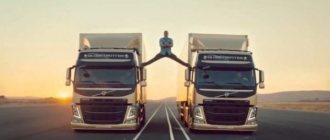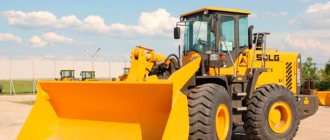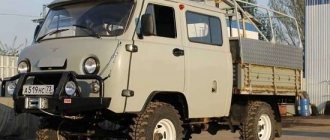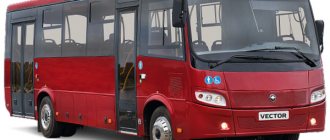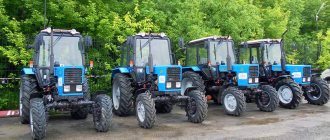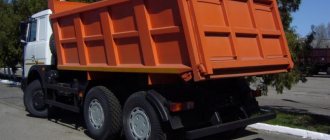When purchasing special equipment, consumers pay attention to the performance, maneuverability of the machine, level of automation, adaptability to the climate of the region, and many other important points. Fuel consumption, as practice shows, is not a criterion for choosing equipment, despite the fact that economical consumption of fuel and lubricants is the most important condition for the rapid payback of the unit, one of the ways to reduce production costs.
The manufacturer's instructions indicate fuel consumption standards, but you cannot rely on this indicator, since it reflects fuel consumption under ideal conditions. Each type of special equipment is operated in an individual mode, which is determined by the specifics of the enterprise’s activities. The quality of fuels and lubricants and the organization of maintenance play a huge role in maintaining a rational level of consumption of consumables.
Basic and individual fuel consumption indicators
For special equipment, fuel consumption is calculated according to a specific algorithm. A specialized car is, first of all, a vehicle, therefore, when determining consumption standards, fuel consumption per 100 km is taken into account (as with a regular car). To this indicator is added the fuel consumption rate for 1 hour of equipment operation (excavator buckets, crane and drilling rigs, dumps, plows, grabs, etc.). Correction factors are applied taking into account climatic and seasonal operating conditions.
Individual indicators are calculated based on the actual operation of the machine, taking into account factors affecting fuel consumption.
Serious deviations from the basic standard can be caused by several factors:
- Engine and hydraulic system malfunctions;
- Aggressive driving style, speeding;
- Use of low-quality fuel and lubricants;
- Adverse weather conditions, off-road conditions.
The amount of fuel burned while driving depends on the type of road surface and the weight of the towed equipment. Correct determination of diesel fuel consumption, taking into account the above factors, is possible if all working components of the equipment are in good condition.
To determine the required value ( fuel and lubricant consumption for special equipment ), it is necessary to multiply the indicator of specific fuel consumption (R) by the power of the power unit (N), and by a factor of 0.7 (conversion from kW). The indicator will be even more accurate if you apply a correction factor that reflects the load capacity (full load - 1, partial - 0.8 or 0.6).
When calculating the consumption standard for an excavator, it is taken into account that a diesel engine consumes 0.220 l/kWh of fuel (0.165 l/hp/h). Correction factors for tracked and wheeled vehicles reflect the degree of loading (the machines do not work constantly, but are used to perform certain operations).
The consumption rate will be the product of the following values:
- Specific fuel consumption (q)
- Engine power (N);
- Fuel density (R);
- Ratio of operating time at a given Kalevala rotation speed (k1).
Specific fuel consumption and engine power are indicated in the manufacturer's instructions.
Loaders
Diesel fuel consumption rates per hour of operation for the most popular forklifts in the Russian Federation:
- Ausa C11M, Kubota D902-ES07(13.6) engine – 4.5 l.
- Bauman HX 40/12/51 TR, power unit D754E2(50) – 2.4 l.
- Bobcat S300, Kubota V3300-Di-T turbo(58) engine – 6.4 l.
- BT Cargo CBD 5.0, power unit John Deere 4045D(56) - 3.3 l.
- CASE 580 Super R backhoe loader, CNH UK Limited(72) engine - 7.0 l.
- Caterpillar 232B, CAT 3024C(37) power unit - 5.4 liters.
- Caterpillar 924GZ, Perkins-3056E engine (129.5) - 13.3 liters.
- D-16, Volkswagen 1.9D(56) power unit - 1.8 l.
- Daewoo D30-S2, DV-33 engine – 2.3 l.
- Doosan D20SC-2, power unit Cummins A2300(32) - 2.1 l.
- GPW-2009, engine, D-2500 – 2.0 l.
- HC CPCD18N-RW9, Isuzu C240 power unit – 2.1 l.
- Heli CPCD50, Isuzu 6BB1 engine – 4.1 l.
- Komatsu FD25T-16, power unit 4D94LE – 2.0 l.
- Linde H60D, engine BF6M1012E (85) - 4.3 l.
- Mitsubishi FD45, S6E power unit – 3.7 liters.
- Nissan FD01A40Q2, engine TD-27(42.5) – 3.3 l.
- Still R70-16, power unit VW ADG(30) – 2.0 l.
- TCM FD35T3S, Nissan QD32 engine – 2.7 l.
- Toyota 02-7FD25, power unit 2Z(49) – 2.5 l.
- Amkodor 342S4, engine D-260.1 – 8.7 liters.
- DV-1661-33-10, power unit D-2500K – 2.9 l.
- DP 1604, engine D-120.05 – 2.6 l.
- Lev-41.030, power unit ZMZ-53 - 6.8 l.
- PB-35, AM-41 engine – 6.0 l.
- PK-6, power unit YaMZ-8482.10 – 27 l.
- TO-156, SMD-62 engine – 11.4 liters.
Renetop products:
The importance of complying with fuel consumption standards
For enterprises using special equipment, compliance with fuel consumption standards is of particular importance, since these indicators are controlled by the tax service. The official document regulating the standards for consumption of fuels and lubricants by different types of vehicles is the order of the Ministry of Transport of Russia No. AM/23r dated March 14, 2008.
There are other legislative documents that can be used to determine the standard. These are indicators approved by the relevant departments (for forestry, public utilities, agriculture, etc.).
If the technical documentation for special equipment does not contain basic data, you must make a request to the manufacturer or contact a departmental organization.
Separate standards are established for machines operating while parked (loaders, drilling machines, aerial platforms, compressors), and for units performing work in motion (tractors, excavators, bulldozers).
If you find unreasonable excessive fuel consumption or equipment failures, contact the services of our company. We will determine the cause of incorrect operation, carry out repair work, test the equipment, and give useful recommendations. Remember that excessive fuel consumption always indicates problems with the functional systems of special equipment. Take action in a timely manner so as not to overpay for expensive repairs! Contact the technician by phone at 8 (800) 250-63-77 to submit a request for diagnostics, or use the website’s feedback form.
MTZ
Diesel fuel consumption rates per hour of operation of the most popular MTZ tractors in the Russian Federation.
MTZ-80, engine D-240, D-240L:
- Transport mode – 4.4 l.
- Sweeping with a brush - 4.0 l.
- Snow removal with a blade and brush - 6.9 liters.
- Snow removal with a blade – 5.4 l.
- Transport mode with trailer 2PTS-4 – 5.8 l.
- Transport mode with trailer 2PTS-6 – 6.2 l.
Belarus 1223, engine D-260.2, D-260.2S:
- Transport mode with trailer MZHT-10 – 11.8 l.
- Transport mode with trailer MZHT-F-11 – 11.8 l.
MTZ-82.1, engine D-243D-243-202:
- Transport mode – 5.5 l.
- Transport mode with trailer PST-9 – 8.0 l.
- Transport mode with trailer PST-11 – 10.4 l.
- Sweeping with a brush - 4.3 l.
- Snow removal with a blade and brush - 6.9 liters.
- Snow removal with a blade – 6.6 l.
- Snow removal with a brush - 6.3 liters.
- Transport mode with platform PTK-10.2 - 10.4 l.
- Work with a milling cutter – 8.0 l.
- Work with a flat cutter - 5.7 liters.
- Work with a rake - 5.8 l.
What is a waybill
A waybill is a primary document that records the vehicle’s mileage. Based on this document, gasoline consumption can be determined.
Organizations for which the use of vehicles is the main activity must use the PL form with the details specified in Section I of Order No. 368 of the Ministry of Transport dated September 11, 2020.
The document came into force on 01/01/2021. Main innovations:
- A waybill is required for any vehicle operation, regardless of the type and nuances of transportation.
- A new detail “Transportation information” has been introduced.
- It is necessary to indicate the brand of the trailer.
- The responsible person is obliged to indicate the time the vehicle leaves the line and the time it returns.
From 09/01/2021, waybills are filled out taking into account the new rules for technical control of vehicles, approved. by order of the Ministry of Transport dated January 15, 2021 No. 9.
For organizations that use a car for production or management needs, it is possible to develop a PL taking into account the requirements of the Law “On Accounting” dated December 6, 2011 No. 402-FZ.
Do you doubt the correctness of the posting or write-off of material assets? On our forum you can get an answer to any question that raises your doubts. For example, in this thread you can clarify what the basic fuel consumption rate is recommended by the Ministry of Transport.
An example of an order for approval of a DP can be found here.
In practice, organizations often use PLs that were approved by Decree of the State Statistics Committee of the Russian Federation dated November 28, 1997 No. 78. This resolution has PL forms depending on the type of vehicle (for example, Form 3 - for a passenger car, Form 4-P - for a truck) .
For a sample of filling out the updated waybill, see here .
You can learn about filling out waybills taking into account the latest innovations in the Ready-made solution from ConsultantPlus. Trial access to the legal system is free.
and you can get a prompt answer on filling out the waybill in our discussions in the VK group .
Waybills must be recorded in the waybill register. Accounting for waybills and fuels and lubricants is interconnected. In organizations that are not motor transport by nature of activity, PLs can be drawn up with such regularity that it is possible to confirm the validity of the expense. The main thing is to confirm the expenses. Such conclusions are contained, for example, in the letter of the Ministry of Finance of Russia dated 04/07/2006 No. 03-03-04/1/327, the resolution of the Federal Antimonopoly Service of the Volga-Vyatka District dated 04/27/2009 No. A38-4082/2008-17-282-17-282.
Read about waybills for individual entrepreneurs in the article “What are the features of a waybill for individual entrepreneurs (form)?”
How to calculate fuel yourself?
The cost of calculating fuel consumption standards is 3,000 rubles (VAT is not assessed according to clause 2 of Article 346.11 of the NKRF) , per vehicle unit. The calculation period is from 2 days . (regular customers receive a discount). By agreement with the customer, operational standards are calculated, taking into account the operating features (operation of the air conditioner, additional equipment, etc.). There is a license agreement for the use of the method program.
Accounting for fuel and lubricants
Like all inventories, fuel and lubricants are accounted for in the accounting department at actual cost. Expenses that are included in the actual cost are indicated in Section II of FSBU 5/2019 “Inventories”.
Important! Since 2022, inventory accounting has been carried out in accordance with the new federal standard FSBU 5/2019 “Inventories” (it replaced PBU 5/01). ConsultantPlus experts spoke in detail about how the rules for accounting for inventories have changed. You can see the explanations if you get trial access to the legal system. It's free.
Acceptance of fuel and lubricants for accounting can be carried out on the basis of gas station receipts attached to the advance report (if the driver purchased the fuel in cash) or on the basis of coupon stubs (if gasoline was purchased using coupons). If the driver purchases gasoline using a fuel card, then accounting for fuel and lubricants on fuel cards is carried out on the basis of a report from the company issuing the card. Write-off of fuel and lubricants can be carried out using the following methods (section III):
- at average cost;
- at the cost of the 1st time of acquisition of inventory (FIFO).
There is another way to write off - at the cost of each unit. But in practice, it is not applicable for writing off fuel and lubricants.
The most common way to write off fuel and lubricants is at average cost, when the cost of the remaining material is added to the cost of its receipt and divided by the total amount of the remainder and receipt in kind.
Name of machines
Engine utilization over time TOV
by power TOm
I. Excavation machines Single-bucket excavators with bucket capacity, m3: up to 0.4 (1-2 size groups) 0.86 0.60 from 0.4 to 1.0 (3-4 size groups) 0.90 0.50 Trench excavators rotary and chain 0.88 0.50 Rotary excavators (when working in a quarry) with a bucket capacity, l: up to 50 0.88 0.50 up to 100 0.94 0.50 Multi-bucket cross-digging quarry excavators 0.88 0.50 Levelers 0.90 0.40 Bulldozers 0.86 0.40 Scrapers 0.92 0.80 Motor graders 0.90 0.50 II. Machines for repair and maintenance of road surfaces Marking machines, asphalt heaters 0.63 0.30 Machines for cleaning and cutting cracks 0.63 0.50 Machines for preparing and distributing sludge, for eliminating unevenness 0.63 0.70 Machines for constructing strips for widening and strengthening slopes 0.63 0 .40 III. Snow plows Rotary screw 0.77 0.60 Gas jet 0.77 0.85 IV. Machines for soil and road compaction Rollers 0.79 0.50 Tamping machines 0.42 0.27 Vibrating plates 0.63 0.60 V. Tractor-based rippers 0,86 0,80 VI. Machinery and equipment for road surfaces Road milling machines 0.60 0.60 Cement distributing trucks 0.70 0.40 Soil mixing machines, asphalt distributors, bitumen trucks 0.83 0.40 Automatic mixing plants 0.60 0.60 Asphalt pavers 0.78 0.30 Equipment for reinforcing transverse joints in cement concrete pavement 0.60 0.60 Machines for making rough surfaces 0.63 0.40 Seam cutters 0.42 0.30 VII. Machines and equipment for preparing concrete mixtures Cyclic concrete mixers: stationary, capacity, l: up to 500 0.80 0.40 St. 500 0.80 0.50 mobile capacity, l: up to 500 0.60 0.50 St. 500 0.70 0.50 Mortar mixers: mobile 0.20 0.40 stationary 0.70 0.40 Concrete mixer trucks, concrete trucks, mortar trucks 0.82 0.50 Concrete pump trucks 0.66 0.60 Continuous and cyclic batchers 0.90 0 .50 Mobile and stationary concrete pumps 0.60 0.50 VIII. Vibrating machines Vibrators: general purpose 0.20 0.90 deep 0.20 0.80 Vibratory feeders 0.15 0.90 IX. Cranes, lifting devices, loading and unloading equipment Automotive jib cranes with lifting capacity, t: up to 10 0.74 0.25 St. 10 0.79 0.25 Pneumatic jib cranes 0.90 0.35 Crawler jib cranes 0.90 0.30 Single-bucket loaders 0.86 0.30 Pipe layers 0.95 0.25 X. Piling machines Sheet pile pullers 0.82 0.30 Sheet pile loaders 0.82 0.70 Diesel hammers, pile cutting devices, vibrating loaders, pile driver installations 0.82 0.30 XI. Crushing and processing equipment Stationary crushers 0.86 0.60 Mobile crushing and screening plants, capacity, m3/h: up to 25 0.94 0.60 St. 25 0.94 0.70 Screens, feeders, conveyors (conveyors) 0.82 0.60 XII. Reclamation machines Plow and milling trenchers, sewer cleaners 0.83 0.50 Grader elevators 0.85 0.50 Dredging equipment with capacity, m3/h: up to 50 0.79 0.60 St. 50 0.68 0.50 Sets of machines for lining channels with monolithic concrete, depth, m: up to 1.5 0.70 0.60 St. 1.5 0.60 0.60 Vibroforms for concreting channels 0.70 0.60 Slab layers for lining channels with precast concrete 0.70 0.60 Drilling machines 0.60 0.40 XIII. Construction and finishing machines For plastering work: plastering units, mobile mortar mixers, mortar pumps with capacity, m3/h: 0.40 0.70 to 2 0.40 0.70 St. 2 0.30 0.60 Plastering stations 0.60 0.50 For painting work: compressors 0.70 0.60 painting stations 0.50 0.70 painting mixers 0.60 0.70 mixers with pump 0.30 0, 70 Note.Along with the values of the coefficients given in the table, the actual, local values of these coefficients can be used in the calculation.
Write-off of gasoline using waybills (tax accounting)
If everything is quite simple with the write-off of fuel and lubricants in accounting, then the recognition of these expenses in tax accounting raises questions.
1st question: in what expenses should fuel and lubricants be taken into account? There are 2 options here: material or other expenses. According to sub. 5 p. 1 art. 254 of the Tax Code of the Russian Federation, fuels and lubricants are included in material costs if they are used for technological needs. Fuel and lubricants are included in other expenses if they are used to maintain official vehicles (subclause 11, clause 1, article 264 of the Tax Code of the Russian Federation).
IMPORTANT! If the main activity of an organization is related to the transportation of goods or people, then fuel and lubricants are material costs. If vehicles are used as service vehicles, then fuel and lubricants are other expenses.
The second question: should we normalize the costs of writing off fuel and lubricants within the framework of tax accounting? The answer to this can be found by linking the details of the waybill and legislative norms:
- The PL calculates the actual use of fuel and lubricants. The Tax Code of the Russian Federation does not contain direct indications that expenses for fuel and lubricants should be taken into tax accounting only according to actual standards.
- The PL contains information only about the actual mileage. However, fuels and lubricants can be calculated according to order No. AM-23-r, paragraph 3 of which states that the standards established by it are also intended for tax calculations. The Ministry of Finance of Russia in its letters (for example, dated 03/22/2019 No. 03-03-07/19283, dated 06/03/2013 No. 03-03-06/1/20097) confirms that order No. AM-23-r can be used to establish justification of costs and determine the cost of fuel and lubricants in tax accounting according to standards multiplied by mileage.
IMPORTANT! In tax accounting, fuels and lubricants can be taken both according to actual use and according to the quantity calculated based on the standards.
In practice, a situation is possible when an organization uses transport for which fuel consumption standards are not approved in Order No. AM-23-r. But in paragraph 6 of this document there is an explanation that an organization or individual entrepreneur can individually (with the help of scientific organizations) develop and approve the necessary standards.
The position of the Ministry of Finance of Russia (see, for example, letter dated June 22, 2010 No. 03-03-06/4/61) is that before developing standards for the write-off of fuel and lubricants in a scientific organization, a legal entity or individual entrepreneur can be guided by technical documentation.
There are no explanations in the Tax Code of the Russian Federation on how to act in such a situation. In cases where an organization independently established standards for writing off fuel and lubricants and, having exceeded them, took into account the amount of excess fuel use in tax accounting, the tax inspectorate may not recognize this as an expense. Accordingly, additional income tax may be charged. In this case, the court may well support the position of the inspectorate (see, for example, the resolution of the Administrative Court of the North Caucasus District dated September 25, 2015 in case No. A53-24671/2014).
Read about the amount of fines for not having a waybill in this article .

